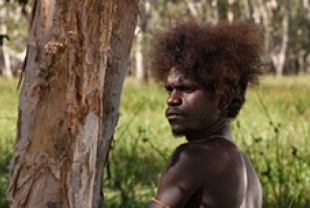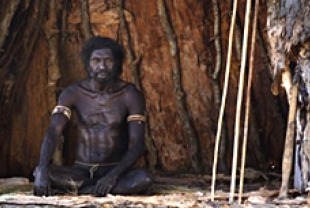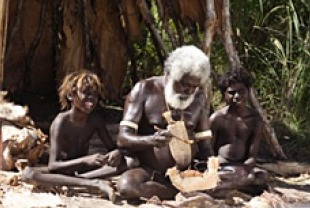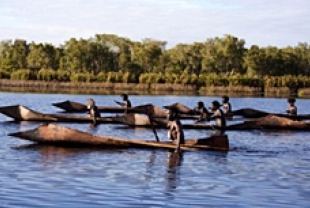This culturally authentic and spiritually rich Australian film directed by Rolf de Heer (The Quiet Room, The Tracker) swept the Australian Academy Awards, winning Best Film, Best Director, and Best Cinematography. The film is the result of a partnership between the director and the Ramingining Aboriginal community as the first feature made entirely in an Australian indigenous language and based on native stories. English storytelling by famed aboriginal actor David Gulpilil and subtitled Ganalbingu language gives the film additional authenticity. As in the Canadian Inuit feature The Fast Runner, we are plopped down in the mist of a primal adventure story that contains universal elements of drama including sexual desire, community law, distrust of outsiders, sorcery, violence, and death.
Underlying Ten Canoes is the respect Aboriginals have for the art of storytelling as a means of entertainment and a carrier of tribal meaning and solidarity. In the film, a tribal elder named Minygululu (Peter Minygululu) is leading men on an expedition that includes harvesting bark to make canoes and then going through a swamp hunting goose eggs. When he learns that his younger brother Dayindi (Jamie Gulpilil) is lusting after his third and youngest wife, he decides to tell him an ancient story from long ago about a young man in a similar predicament. The point of the story is to teach his brother the "proper way' to behave. Lives can be transformed when a tale is properly understood and taken to heart.
Minygululu tells the story in a meandering way, stopping and starting as they perform various tasks in the swamp. Young Dayindi grows impatient with all the delays and seeming excursions in the account but for Minygululu the story is a large tree that just keeps branching out. He has deep respect for the ancestors and for their way of doing things. At one point, the elder notes that his younger brother just wants him to cut to the action sequence where the tribe goes to war with another tribe. Minygululu implies that violence is the only thing that interests young men whereas elders are interested in the wisdom that can be gleaned from stories and from the lives of the ancestors.
One of the most fascinating episodes in Minygululu's story is that of Makaretta or payback. Ridjimiraril (Crusoe Kurrdal), a hunter and leader of the tribe we are following, slays a stranger with a spear and must undergo a formal and ritualized form of punishment. Warriors from the aggrieved tribe throw spears at him and another member of his tribe acting as his partner until blood is drawn. They try to dance away from the spears. When one is hit by a spear, sometimes fatally and sometimes not, justice is paid, and men in both tribes agree not to go to war with each other. The matter is resolved. That would not be a bad way to solve the seemingly intractable civil wars and other confrontations around the world in these troubled times.
Ten Canoes also shows the large and important role of sorcery in the lives of Aboriginal communities. Strangers can bring bad spirits with them and that is why they are usually shunned. The sorcerer (Philip Gudthaykudthay) in Minygululu's story lives alone and conjures up powerful medicine with his fear-based ideas. Luckily the tribe has an antidote in the buffoonery of Birrinbirrin (Richard Birrinbirrin), a big-bellied elder who is obsessed with honey. There are plenty of jokes about flatulence and sexual performance among the men as they go about their tasks in the swamps fighting off mosquitoes and avoiding crocodiles.
Ten Canoes offers an authentic look at aboriginal life that ought to appeal to audiences around the world whose lives are animated by the same universal desires, fears, and human flaws. Best of all, this ambitious and sturdy Australian film demonstrates that a story well told is good medicine for all who take it to heart.
Special DVD features include "The Balanda and the Bark Canoes — The Making of Ten Canoes", an aerial map of Arnhem Land, interviews with Peter Djigirr and director Rolf de Heer, a Photo Gallery, and a DVD-Rom Study Guide.



